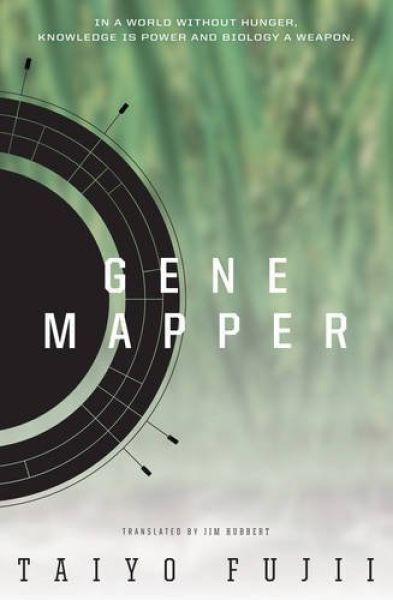Grain for Grain, Sun and Rain
Gene Mapper
By Taiyo Fujii

23 Aug, 2017
0 comments
Taiyo Fujii’s Gene Mapper is a standalone futuristic thriller, first self-published in 2012. The 2015 English translation is by Jim Hubbert.
The great red-rust blight was a tragedy for the ten million Asians who starved to death as a result. For companies like L&B, it was an opportunity to replace unreliable natural crops with their carefully designed and wholly owned commercial seed. L&B promises a reliable food supply and security from famine to the world’s twelve billion people.
At least, that’s the plan.
Gene mapper Mamoru Hayashida is woken from a sound sleep by the dire news that a field of L&B’s new flagship rice crop, SR06, has seemingly suffered dysgenic collapse. Mamoru is charged with finding out what happened and how. And doing so NOW. The affected field can been seen by ubiquitous orbiting satellites. News of the event will soon spread; public trust in GM crops will plummet and with it, the company’s stock.
Mamoru heads to Ho Chi Minh City to take a closer look at the stricken field. Somehow, despite being surrounded by a vast DMZ designed to prevent contamination, either the field has become infested with a thought-to-be-extinct legacy strain of rice vulnerable to red rust or—far less likely—SR06 has somehow transformed into its vulnerable predecessor.
What happened is less important than how it happened and why. It would be bad enough if this were some act of sabotage by commercial rivals or ecoterrorists. It would be even worse if it turned out that GM crops suffered from some previously undetected vulnerability. Saboteurs can be tracked down and arrested; a dysgenic collapse could doom millions.
~oOo~
Twelve billion people by 2036 seems unlikely.
A plot point that stopped being futuristic a few weeks ago: not only is it possible to embed malware into DNA to confound scanners, it’s been done in real life. Ah, progress.
This novel is full of genies-escaping–from-their-bottle moments whose implications fail to panic the task-focused Mamoru. He believes in GM crops. He wants GM crops to succeed. He believes that technologies, once invented, cannot be wished away. Rather than collapsing in angst, he does his best to steer events in the least bad direction available: he embraces the Anthropocene rather than fretting about it. No guarantee the world won’t collapse into ecological carnage a week after the book ends but if it does, it is not because he shirked his duty.
Mamoru’s commitment to the idea that one cannot turn back time may explain why it is that he accepts aspects of his life that some readers might find lamentable. His quarters are cramped and Spartan? Yes, but they can be vastly improved if seen through VR. Nothing to be done in reality, so accept. He’ll move on to issues that he can affect.
The novel itself might have used some glossy VR. It groans under the weight of its infodumps; the antagonists are rather cartoonish; some of the background history (a thinly disguised Google has accidentally killed the Internets) seemed both implausible and unnecessary to the plot. These defects wouldn’t be as noticeable in a book as long as the same author’s Orbital Cloud, but Gene Mapper is a short book without pages to spare. John M. Ford could have been a useful guide for Fujii.
This is very much a first novel. It shows promise but would have benefited from the attentions of a professional editor. Still, Gene Mapper was strong enough that Fujii’s next novel did go to a professional publisher.
Gene Mapper is available here (Amazon) and here (Chapters-Indigo).
Please direct corrections to jdnicoll at panix dot com.
